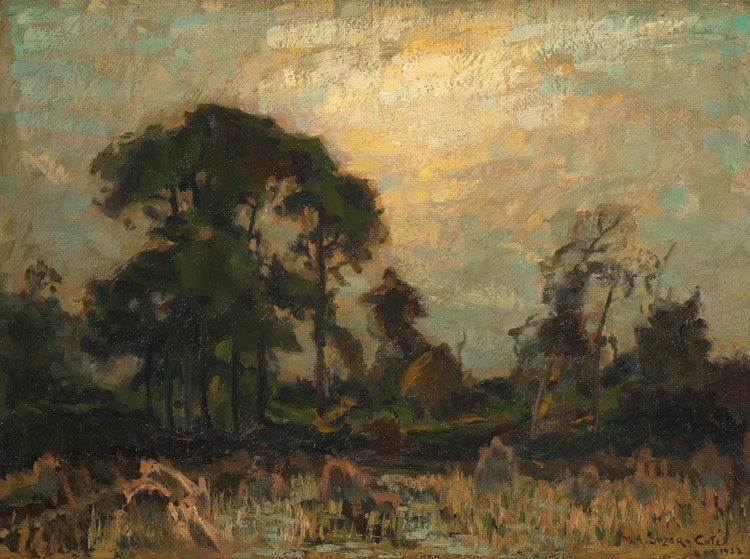Near Arthabaska at Dusk by Marc-Aurèle de Foy Suzor-Coté

Marc-Aurèle D.F. Suzor-Coté
Near Arthabaska at Dusk
oil on canvas
signed and dated 1922 lower right
20 x 27 ins ( 50.8 x 68.6 cms )
Auction Estimate: $25,000.00 - $35,000.00
Price Realized $23,600.00
Sale date: May 28th 2019
Masters Gallery, Calgary
Private Collection, Calgary
Laurier Lacroix, Suzor-Coté: Light and Matter, National Gallery of Canada, Ottawa, 2002, page 161-63
Suzor-Coté took on a nomadic lifestyle for over a decade, shifting between Arthabaska and Montreal, while taking several short trips throughout Quebec, Ontario, the United States, and back to France. “Near Arthabaska at Dusk”, completed in 1922, depicts a moody, romantic landscape of his hometown at sunset. Suzor-Coté particularly enjoyed studying the variations of light at different times of day, as reflected in the luminous sky dappled with strokes of aqua and yellow.
Rejecting more academic and history painting, Suzor-Coté focused instead on representing nature as a way of forging an identity for his home country. Canadian painters who trained primarily in France and Great Britain, including Suzor-Coté, were beginning to suggest a new way of defining the Canadian identity as they sought to explore the uniqueness of the landscape around them. Laurier Lacroix describes Suzor-Coté’s involvement with this change in Canadian art in his depiction of Arthabaska: “The representation of landscapes in descriptive or picturesque form, a tradition that developed throughout the 19th century in Quebec, now had to make way for a more indigenous and interior vision. For Suzor-Coté, the area around the village of Arthabaska was the ideal location to establish such a relationship with nature. Suzor-Coté succeeded in grasping the atmosphere of this corner of the country, or at least in grafting his own perception on it.”
Share this item with your friends
Marc-Aurèle de Foy Suzor-Coté
(1869 - 1937) RCA
Suzor-Coté was born in 1869 in the village of Arthabaska, Quebec. Although the young Marc-Aurèle de Foy Suzor-Coté excelled in both musical and artistic pursuits, his love of painting won precedence and he travelled to Paris in 1891 for three years of art studies at the École de beaux-arts. He returned to North America briefly, pursuing commission work, before returning to Europe for an extended period between 1897 and 1907.
By 1906 he had left behind the academic realism of his early work, developing instead a bold impressionistic style. Once back in Canada he found his greatest inspiration in the Canadian landscape itself. He painted landscape in a forceful impressionistic style which was unfamiliar to Canadian audiences of the time.
The multi-talented Suzor-Coté was also easily able to make the shift from painting to working in three dimensions. His bronzes were cast in New York at the Roman Bronze Works, and became sought after by collectors in Canada and the United States. Suzor-Coté won the Jessie Dow prize for best painting at the Art Association of Montreal in 1914 and again in 1925. By 1925, he had made a significant contribution to impressionism in Canada, influencing younger artists to paint the Canadian landscape in a new manner.

